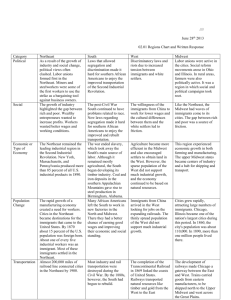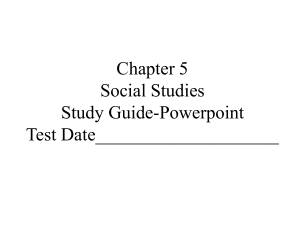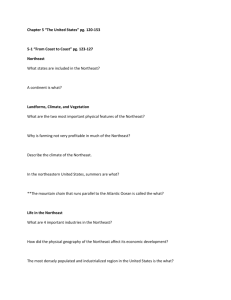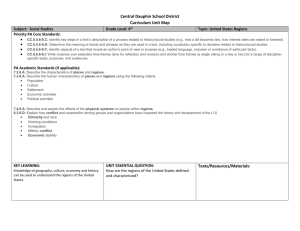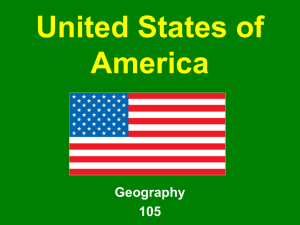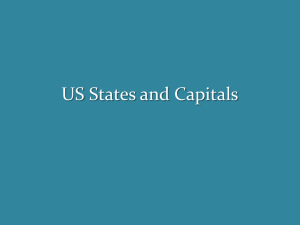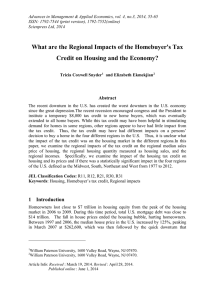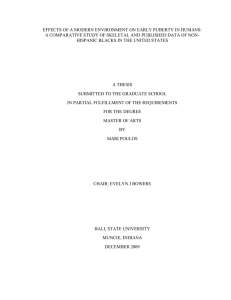Chapter 6 - Cloudfront.net
advertisement
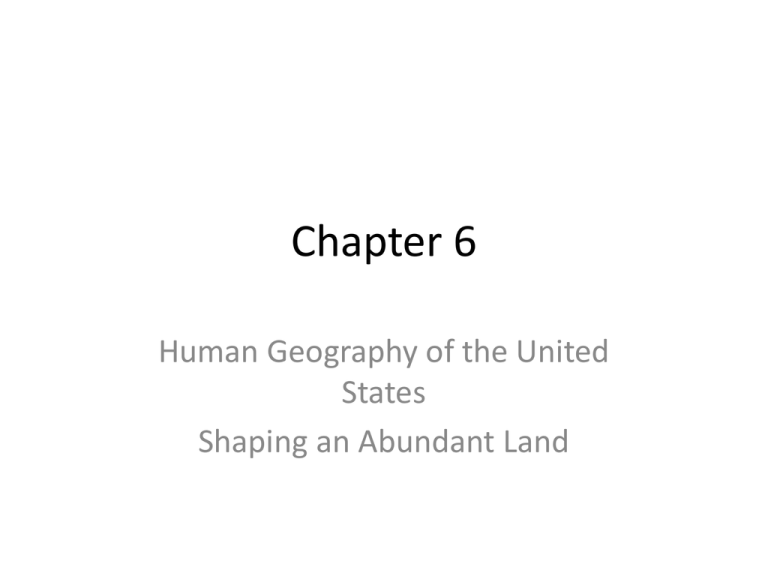
Chapter 6 Human Geography of the United States Shaping an Abundant Land History and Government of the United States 6.1 • The Untied States is the third largest country in both size and population • The United States is a nation of immigrants – Nomads crossing Beringia and the Bering Sea • Native Americans, Athapascans, Aleuts and Inuit – Spanish arrived in the 1500s: seeking Gold and other treasure • St. Augustine, FL is the oldest permanent European settlement in the USA – France: Came in the 1600s for fish and fur – England: Came to settle colonies • European settlement often displaced Native Americans – With “secret” biological weapons of mass destruction: diseases First contact of Europeans with the Americas led to the greatest ecological events in history Establishing the Union • English won land from the French during the French and Indian War (1763) – Colonists fought the British efforts to make them share paying for the war • Colonists won the Revolutionary War (17751783) • US expanded with the Louisiana Purchase (from France) of 1803 – Land west of the Mississippi to the Rockies • Early immigration was from Western Europe to the Northeast Sectionalism • The different economic systems that developed in each section of the US led to competing interests – Northeast: Industry and trade – Southeast: Cash crop agriculture based on slavery – West: Staple crop agriculture, mining and livestock • One result was the Civil War – Fought 1861-1865 – North won In the second half of the 1800s, millions of Americans were on the move • Settlement expanded westward • During the same period, immigrants poured in from Europe • During the 19th century, the USA transformed from a rural agricultural nation to an urban, industrial one As the 20th century began, the USA was the most powerful country in the Western Hemisphere • Up to this point the US was practically selfsufficient • Beginning with the Spanish American War, and through World Wars I & II, the US became the strongest world power The final half of the 20th century was a time of rapid social change • Movement: – Large numbers of families moved to suburbs – Many moved west and south to warmer climates – Immigrants continued to flock to the USA • The 60s and 70s – Civil Rights movement – Feminist movement – Students and others protested the Vietnamese War • Technological change – Computers revolutionized the workplace – Providing services and informational technology surpassed industrial production in importance The United States & Globalization • The US became the world’s greatest economic power – The rest of the world competes with the US as they develop economically – Many industrial jobs have been exported to other countries • The USA led the noncommunist nations during the Cold War • When communism in Europe collapsed in 1991, the US became the world’s sole superpower Government: the United States is a Presidential Federal Republic • The current governmental form comes from the Constitution of 1787 – People are governed through elected representatives – Separation of Powers between Legislative, Executive and Judicial branches • The president is NOT a member of the legislature • Congress (Legislature): House of Representatives and Senate • The 50 states also have legislative, executive and judicial branches and exercise powers not specifically granted to the federal (national) government) Economy and Culture of the United States 6.2 • The United States is the leading economic power • The US economy is run largely on freeenterprise (free market, capitalist) system An agricultural and industrial giant • The US not only feeds itself, but also helps to feed the world • Different part of the US provide different products – Midwest and South: crop farming – West: Livestock The industrial output of the US is larger than any other country • Advances in technology revolutionized industry and led to new products and methods Postindustrial economy • Service industries (producing a service rather than a product) – Nearly three-fourths of American workers work in the service sector • Information processing, finance, medicine, transportation, and education • Known as postindustrial economy • The US leads the world in both exports and imports – Exports: raw materials, agricultural products, and manufactured goods – Imports: automobiles, electronic equipment, machinery and apparel – Our chief trading partners are Mexico and Canada • Many US corporations engage in business worldwide and are called multinationals Because the USA is a nation of immigrants, it is a nation of different races and ethnicities • English is the dominant language • Religious freedom is guaranteed by the Constitution Arts and Popular Culture • Native Americans made pottery, weavings and carvings • Europeans brought artistic traditions of their homelands • Truly American styles developed in the 1800s – Paintings of the expansive landscape – Scenes of American life on both the frontier and in the cities – Skyscrapers shaped world architecture – Today: motion pictures, popular music • Hollywood • African influence: jazz, blues, gospel, rock and roll, hip-hop • Southern (European ancestry) influence: country, bluegrass American Life today • • • • • • More than 280 million people live in the USA 80% live in cities 50% of American Adults are employed America has always valued education Americans enjoy a high amount of leisure time Not all Americans live well Subregions 6.3 Subregions of the United States 6.3 • Northeast – 5% of the land area, but 20% of the population – Six northern states: Vermont, Maine, Massachusetts, Connecticut, New Hampshire, and Rhode Island make-up New England – Pennsylvania, New York and New Jersey are known as the Middle Atlantic States – One of the first areas settled by Europeans • Served as the “Gateway” for many immigrants More Northeast • The first activities were fishing and farming • Coastal and inland waters turned the region into a heart of trade, commerce and industry • Many “rustbelt” industries have moved to the “sunbelt” or overseas • The nations first Megalopolis developed in the Northeast: “Boswash” Midwest • America’s heartland – 20% of area and 25% of population of the US – Mostly flat plains, with numerous waterways • Great Lakes, Mississippi River and its tributaries • The nation’s “breadbasket” – Fertile soils, adequate rainfall, and a favorable climate enable farmers to produce more food and feed more people than any comparable area in the world – Agriculture is the foundation for many of the region’s industries • meatpacking, food processing, farm equipment, and grain milling More Midwest • Its central location and excellent waterways make the Midwest a trade and distribution center – Chicago is the cultural, financial and transportation “hub” – Others are also located near large bodies of water: • • Cleveland, Detroit, Milwaukee are on the Great Lakes; Cincinnati, St. Louis, Minneapolis, St.. Paul, and Omaha developed along rivers • Changing face of the Midwest: – Number of farms is declining; – Cities are growing; – Industries are moving to the sunbelt and overseas The South • 25% of area and 33% of population • 11 of the sixteen states were part of the Confederacy during the Civil War • Like the Northeast, the South was an early destination for immigration • Its mix of cultures comes from – early European settlement, – imported slave labor, – and later immigration of Mexicans into Texas, FrenchCanadian “Cajuns” and Creoles to Louisiana • Once a rural, agricultural area, the South is rapidly changing and its cities growing The West (Hey, that’s us!) • 50% of the area, 20% of the population • People settle where landforms and climate are favorable – Deserts are sparsely settled, yet California is the most populous state • The West is the most rapidly growing region • Los Angeles is the West’s cultural and commercial center Developing the West • Helped by air conditioning and irrigation – The Colorado River has been diverted to serve many areas (except Mexico) • Las Vegas, Tucson and Phoenix, as well as L.A. • Economic activities: farming, ranching, food processing, logging, fishing, mining, oil refining, tourism, filmmaking and the production of computers • The West has many good harbors that make foreign trade—especially with Asia—important: – Los Angeles/Long Beach, Seattle, San Francisco, San Diego


